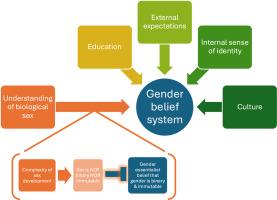教授生物性别决定的复杂性,目的是创造一个更具包容性的课堂,或许还能挑战性别二元过于简单化的修辞的关键部分。
IF 2.1
3区 生物学
Q2 DEVELOPMENTAL BIOLOGY
引用次数: 0
摘要
个人对性别严格定义的信念构成了巨大的社会成本,从性别收入差距、对跨性别者和性别多样化者的暴力和歧视,到全球经济损失。这些信念通常根植于本质主义思想,即性别是独特的、不重叠的、不可改变的、基于生理的。性别是一个多维度的社会概念,部分是由对性别的认知所决定的,性别是一个独特的概念,指的是一系列生物特征。与生物性别是严格二元的观点相反,控制性别特异性组织和器官发育的遗传、分子和细胞机制可以而且确实导致了不严格的男性或女性的结果。换句话说,在性别决定中起作用的机制表明,生物性别不是二元的,而是双峰的。在某种程度上,对生理性别的认知会影响个人对性别的看法,我认为,向学生传授性别决定的真正复杂性,有可能挑战对性别过于简单化的看法。如果生理性别既不是二元的,也不是不变的,那么也许社会性别这个复杂的、社会建构的概念也不是。通过对这些发展过程的更深入的了解,那些学习到生理性别不是离散的学生可能会对他们关于性别离散的本质主义信念产生挑战。他们可能还会获得新的证据,反驳在公共话语中如此普遍的关于生理性别的言论,尤其是在为反跨性别立法辩护时。在这篇文章中,我简要地回顾了生命之树上性别发展机制的多样性,重点是哺乳动物,以及对我们对人类性别理解的影响。我讨论了一些促成我们对性别二元观念的因素,以及对社会不同方面的负面影响。然后,我回顾了一些关于发育生物学中性别和性别包容性教学的考虑,包括我在课程中使用的一个示例课程计划,以及描述改变本科生性别信仰系统可能更广泛地减少性别偏见的方法。本文章由计算机程序翻译,如有差异,请以英文原文为准。

Teaching the complexities of biological sex determination with the goal of creating a more inclusive classroom and perhaps challenging key components of the oversimplified rhetoric of the gender binary
Individual belief in a rigid definition of gender underlies significant social costs, from the gender pay gap, violence and discrimination against transgender and gender diverse people, to global economic losses. These beliefs are often rooted in essentialist thinking that gender is distinct, non-overlapping, unchangeable, and biologically based. Gender is a multidimensional social concept, partly informed by perceptions of sex, which is a distinct concept referring to a collection of biological traits. Contrary to the belief that biological sex is strictly binary, the genetic, molecular, and cellular mechanisms that control development of sex-specific tissues and organs can and do result in outcomes that are not strictly male or female. In other words, the mechanisms at play in sex determination suggest that biological sex is not binary, but instead bimodal. To the extent that perceptions of biological sex inform an individual's beliefs about gender, I posit that teaching students about the true complexity of sex determination has the potential to challenge overly simplistic beliefs about gender. If biological sex is neither binary nor immutable, then perhaps gender, a complicated, socially constructed idea, isn't either. Through greater understanding of these developmental processes, students who learn that biological sex is not discrete may have their essentialist beliefs regarding discreteness of gender challenged. They may also gain new evidence to contradict the rhetoric around biological sex that is so prevalent in public discourse, particularly in the justification of anti-transgender legislation. In this article, I briefly review the diversity of sex development mechanisms across the tree of life, with a focus on mammals, and the implications for our understanding of human sex. I discuss some of the contributing factors to our binary beliefs about gender and the negative impacts on different aspects of society. I then review some considerations for gender- and sex-inclusive teaching of developmental biology, including an example lesson plan that I use in my course, along with describing ways in which altering undergraduate students' gender belief systems could potentially reduce gender bias more broadly.
求助全文
通过发布文献求助,成功后即可免费获取论文全文。
去求助
来源期刊

Developmental biology
生物-发育生物学
CiteScore
5.30
自引率
3.70%
发文量
182
审稿时长
1.5 months
期刊介绍:
Developmental Biology (DB) publishes original research on mechanisms of development, differentiation, and growth in animals and plants at the molecular, cellular, genetic and evolutionary levels. Areas of particular emphasis include transcriptional control mechanisms, embryonic patterning, cell-cell interactions, growth factors and signal transduction, and regulatory hierarchies in developing plants and animals.
 求助内容:
求助内容: 应助结果提醒方式:
应助结果提醒方式:


